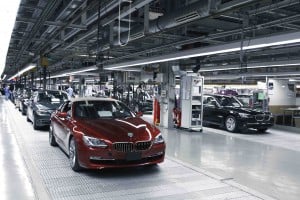Aside from these three automobile manufacturing companies designing and building fast cars, BMW, Mercedes, and Audi also make up a significant portion of the luxury car market. Luxury cars are regarded as the highest quality of mass produced automobiles and thus can be identified as product-based. These companies consider quality to be one of their highest principles as evidenced by BMW’s slogan “The ultimate driving machine.” They care about every measurable detail and the best way to ensure their customers superior quality. These companies have been able to maintain their reputation as the top manufacturers and have been in a fierce competition for the luxury car market share.
The luxury automobile market has expanded in recent years due to increased demand around the globe, but specifically the Chinese market. This has spurred success for luxury cars and has created a desire for more products. These companies therefore have the responsibility of taking action to fulfill the demand and seize the chance to increase growth and profits. BMW is the largest producer of luxury cars currently, however in the third quarter of this year, BMW did not meet the sales growth of its German counterparts. While BMW’s deliveries rose 5.8% from last quarter, Audi saw a 7.2% increase and Mercedes saw a 9%.
After thinking about the importance of quality with the models of these three companies coupled with their contest for the luxury car market, specifically in China. I was curious as to whether or not any of these three companies were concerned with the any of the quality awards or in accordance with certain certifications that were discussed during last week’s online session. After further investigation, I found that BMW is the only one of the three that maintains all the quality management systems at their production facilities in accordance with the standards of the ISO 9000. This helped me understand why BMW is the largest producer of vehicles averaging more than 80,000 more vehicles than its competitors this past quarter. As we discussed, two of the standards of the International Organization for Standardization are to enhance quality and reliability at a reasonable price and increase distribution efficiency and ease of maintenance. These qualities may be the reason why BMW may maintain its position despite outside factors like “Audi push(ing) ahead with a program to invest 22 billion euros ($27.5 billion) by 2018 and Mercedes expand(ing) with vehicles like the upcoming M-Class coupe.” Due to their ability to fulfill their customers needs and maintain and high functioning quality management system, I think they may be able to preserve their position as the biggest manufacturer.
This article also made me think about my work within the construction industry and how buildings are inspected to ensure that the quality is up to the standards of the building code. However, there are certain certifications like LEED, which means the building conforms to detailed guidelines and is an exemplary example of a sustainable and energy efficient building. These structures are known for their quality and ability to lower costs, undercut minimum codes, and provide for further sustainability. Whether it is a quality management standards or a certain certification excellence in class always seems to it manifest itself differently in varied industries.
Questions:
1) Do you think that BMW should be worried about Mercedes-Benz and Audi overtaking them as the biggest manufacturer?
2) Is it worthwhile for Mercedes-Benz and Audi to work towards quality management so that they satisfy the standards of a program like ISO 9000?
3) Do you have any experiences with an award for quality in your line of work that shows that recognized products are indeed exemplary? Or maybe not?
Sources:
http://www.bloomberg.com/news/2014-11-04/bmw-profit-beats-analyst-estimates-on-x5-suv-demand.html
Images:
http://www.imaginelifestyles.com/luxuryliving/2011/05/bmw-stomping-mercedes-benz-just-29-sales

